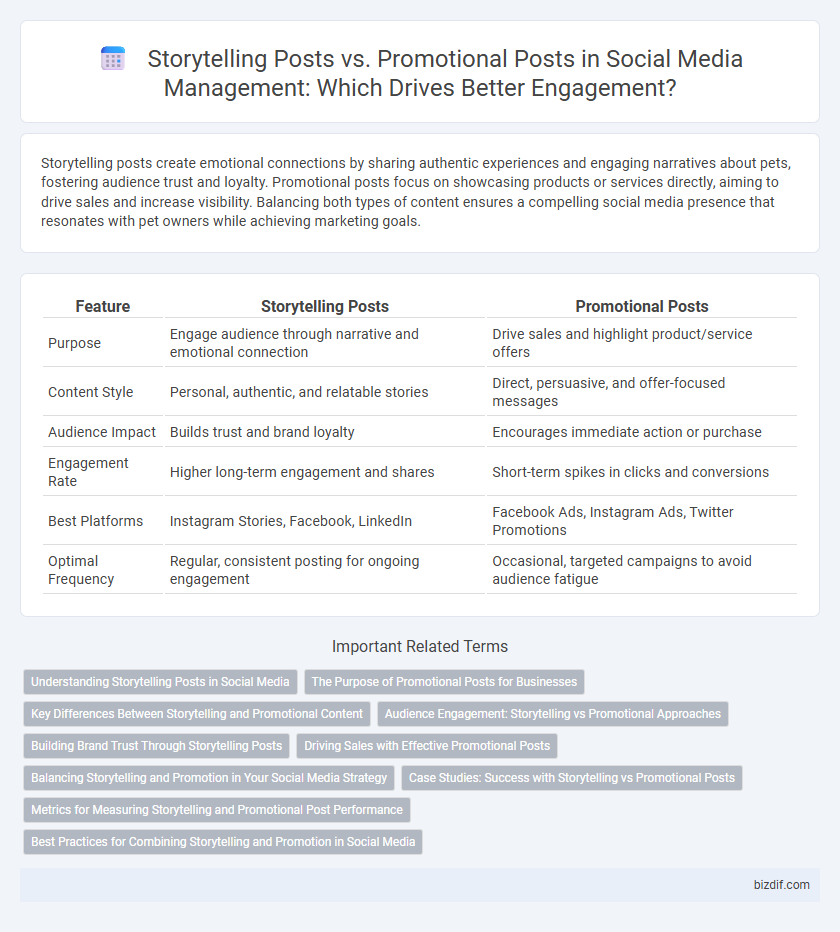Storytelling posts create emotional connections by sharing authentic experiences and engaging narratives about pets, fostering audience trust and loyalty. Promotional posts focus on showcasing products or services directly, aiming to drive sales and increase visibility. Balancing both types of content ensures a compelling social media presence that resonates with pet owners while achieving marketing goals.
Table of Comparison
| Feature | Storytelling Posts | Promotional Posts |
|---|---|---|
| Purpose | Engage audience through narrative and emotional connection | Drive sales and highlight product/service offers |
| Content Style | Personal, authentic, and relatable stories | Direct, persuasive, and offer-focused messages |
| Audience Impact | Builds trust and brand loyalty | Encourages immediate action or purchase |
| Engagement Rate | Higher long-term engagement and shares | Short-term spikes in clicks and conversions |
| Best Platforms | Instagram Stories, Facebook, LinkedIn | Facebook Ads, Instagram Ads, Twitter Promotions |
| Optimal Frequency | Regular, consistent posting for ongoing engagement | Occasional, targeted campaigns to avoid audience fatigue |
Understanding Storytelling Posts in Social Media
Storytelling posts in social media create emotional connections by sharing authentic narratives that resonate with the audience's values and experiences. These posts increase engagement through relatable content, fostering brand loyalty and trust over time. Unlike promotional posts, which focus on direct selling, storytelling builds long-term relationships by prioritizing meaningful interactions and memorable messages.
The Purpose of Promotional Posts for Businesses
Promotional posts primarily aim to drive sales, increase brand awareness, and highlight special offers or new products to target audiences. These posts are designed with clear calls-to-action that encourage immediate customer engagement or conversions. Strategically timed promotional content boosts revenue while reinforcing the brand's value proposition across social platforms.
Key Differences Between Storytelling and Promotional Content
Storytelling posts prioritize engaging narratives and emotional connections, using authentic experiences to build brand loyalty and audience trust. Promotional posts focus on direct calls-to-action and product or service highlights designed to drive immediate sales or conversions. Key differences include storytelling's emphasis on value-driven content and relationship building versus promotional content's goal of boosting short-term marketing metrics.
Audience Engagement: Storytelling vs Promotional Approaches
Storytelling posts foster deeper audience engagement by creating emotional connections and encouraging interactions through relatable narratives and authentic brand experiences. Promotional posts often generate immediate attention but may lead to lower long-term engagement due to their transactional nature and overt sales focus. Brands focusing on storytelling see higher retention rates and more meaningful conversations within their social media communities.
Building Brand Trust Through Storytelling Posts
Storytelling posts create emotional connections by sharing authentic brand narratives, customer experiences, and behind-the-scenes insights, which enhance credibility and foster loyalty. These posts encourage engagement and community building, positioning the brand as relatable and trustworthy. Promotional posts focus on sales and offers but lack the depth needed for long-term trust, making storytelling a crucial strategy for sustainable brand reputation.
Driving Sales with Effective Promotional Posts
Effective promotional posts are designed to convert engagement into sales by highlighting clear calls to action and emphasizing product benefits with compelling visuals. Data shows that promotional posts featuring discounts or time-sensitive offers increase click-through rates by up to 30%. Integrating user-generated content within promotional posts further boosts trust and encourages purchase decisions.
Balancing Storytelling and Promotion in Your Social Media Strategy
Balancing storytelling posts and promotional posts in your social media strategy enhances audience engagement by creating authentic connections while driving conversions. Storytelling posts foster brand loyalty through relatable narratives, increasing organic reach and user interaction. Integrating data-driven promotional content ensures targeted marketing efforts that complement storytelling, optimizing overall campaign performance.
Case Studies: Success with Storytelling vs Promotional Posts
Case studies reveal that storytelling posts generate 60% higher engagement rates compared to promotional posts by fostering emotional connections and brand loyalty. Brands utilizing narrative-driven content report a 30% increase in customer retention and a 25% boost in organic reach on platforms like Instagram and Facebook. In contrast, promotional posts often experience a 15% decline in audience interaction due to perceived sales pressure and reduced authenticity.
Metrics for Measuring Storytelling and Promotional Post Performance
Storytelling posts drive higher engagement rates, with metrics such as average time spent on post and shares indicating deeper audience connection. Promotional posts are best evaluated by direct conversion metrics like click-through rates (CTR) and sales attribution tracking. Monitoring these key performance indicators (KPIs) helps optimize content strategy by balancing brand narrative with sales-driven outcomes.
Best Practices for Combining Storytelling and Promotion in Social Media
Effective social media management leverages storytelling posts to build authentic connections, while promotional posts drive conversions and brand awareness. Best practices include blending engaging narratives with subtle product mentions, maintaining a consistent brand voice, and using analytics to optimize the timing and frequency of each post type. Balancing storytelling and promotion enhances audience engagement and fosters long-term loyalty.
storytelling posts vs promotional posts Infographic

 bizdif.com
bizdif.com